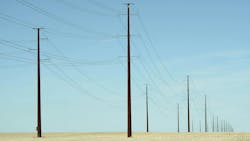BPA Protects Wood Poles and Reliable Service with Fire-Resistant Wrap
The growing threat of wildfires led the Bonneville Power Administration to take another step in its ongoing effort to protect critical infrastructure from wildfire damage. This new initiative centers around the use of fireproof material that wraps around the base of wood transmission poles.
When a wood transmission pole is damaged by fire, line crews must respond promptly. Depending on the severity and location of the fire, a damaged section of line could be out of service for a few hours to several weeks. Using a fire-resistant wrap at the base of the wood pole reduces the likelihood that the pole will be damaged to the point where it needs to be replaced. This saves time, resources, and improves both safety and reliability.
The fire wraps are made of a fiberglass mesh with an intumescent coating that expands and seals around the pole during a fire, creating a protective barrier and effective heat insulation. Activating within 20 seconds of coming in contact with wildfire, the wraps prevent burning, strength loss and pole failure, and withstand flames with temperatures up to 2,100 degrees Fahrenheit.
The effectiveness of the fire wrap was in full display during the Wacoa-Swawilla Fire in late-July, when a large fire broke out on the Colville Reservation near Keller, Washington. Officials believe dry conditions and multiple lightning strikes started the fire that burned for several weeks and consumed 53,462 acres. Even with intense fire severity, none of BPA's wood poles were damaged to the point where they needed to be replaced.
“The results were clear. The fire wrap material effectively protected the wooden structures, resulting in minimal to no damage. This success is a significant achievement in maintaining power for the town of Keller," says Ryan Piche, lineman foreman III for the BPA Grand Coulee District. “Since the lines did not need to be de-energized, the residents in the region were able to access electricity to run their refrigerators, AC units and other important devices," continued Piche.
As the largest transmission provider in the Northwest, BPA is responsible for managing over 15,000 miles of high-voltage transmission lines. Fire season is often the most challenging time of the year as field crews, system operators and many others across the agency diligently work to mitigate wildfires and maintain reliable operations
This challenge has intensified in recent years. According to the National Interagency Fire Center, “Overall, wildfire activity is lasting longer throughout each year and becoming more extreme. Wildfires are occurring earlier in the spring, lasting longer into the fall, and are increasingly intense and complex to manage."
As wildfires increase in severity, utilities are being forced to adapt to this new reality by developing programs to mitigate the impact of these devastating events.
Many groups across BPA collaborated to implement the fire wrap program. The team included Transmission Engineering and Technical Services, Transmission Field Services, Pollution Prevention and Abatement, Transmission Planning and Asset Management, and Supply Chain Services.
Led by civil engineers Kelly Miller and Vlad Slivkov, the team evaluated the pole wraps for requirements such as material cost, ease of installation, use in multiple fires, life span and other variables, ensuring it was a sound investment for the agency.
When deciding which wood poles will receive fire-resistant wraps, the agency considers several key factors, including burn probability, whether the structure is new or pre-existing, and vital input from field staff.
As an avid backpacker, Kelly Miller understands the importance of protecting the environment from the devastation of wildfires. “Each year I backpack, hike, camp and enjoy the natural beauty of the Pacific Northwest. This area is my home, and I'm happy knowing that our agency strives to be a diligent steward of its territory."
With the implementation of the fire wrap program, BPA is taking a significant step forward toward preserving its infrastructure and protecting the environment from the devastating effects of wildfire. This initiative not only supports the agency's strategic goals but also reflects a broader commitment to environmental stewardship in the face of a rapidly changing climate.
